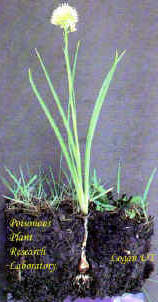|
 Deathcamas is the common name of several species of plants that are poisonous to livestock. The more toxic of these species are grassy deathcamas, meadow deathcamas, foothill deathcamas, and Nuttall's deathcamas. They are found principally in western states. Deathcamas is the common name of several species of plants that are poisonous to livestock. The more toxic of these species are grassy deathcamas, meadow deathcamas, foothill deathcamas, and Nuttall's deathcamas. They are found principally in western states.
Deathcamas is one of the first plants to begin growth in the early spring. In the foothills, deathcamas generally flowers in April and May.  At higher elevations, the plant may flower in late June and July. Unless there is sufficient good quality forage, deathcamas may be heavily grazed and will cause severe losses. Sheep are most likely to eat deathcamas and they are poisoned more frequently than cattle and horses. At higher elevations, the plant may flower in late June and July. Unless there is sufficient good quality forage, deathcamas may be heavily grazed and will cause severe losses. Sheep are most likely to eat deathcamas and they are poisoned more frequently than cattle and horses.
 Deathcamas is a perennial that produces grass like leaves in groups of three from a deeply buried bulb. The plant may be 10 to 40 cm tall. Yellowish-white flowers grow in clusters atop the stalk. Deathcamas is a perennial that produces grass like leaves in groups of three from a deeply buried bulb. The plant may be 10 to 40 cm tall. Yellowish-white flowers grow in clusters atop the stalk.
How It Affects Livestock
All parts of the plant contain toxic steroidal alkaloids that cause cardiovascular failure. Eating the leaves, stems, and flowers generally poisons animals. All parts of the plant are toxic throughout the year; however, poisoning occurs most often in the spring when
deathcamas is relatively abundant. Later in the spring and early summer it senesces and poisonings are rare. About 500 gm of plant are toxic for most sheep (0.6-6% of BW). Poisoned animals usually die; those less seriously affected may recover.
The bulbs are deeper and less accessible to livestock, but they are reported to cause severe illness and death in humans. If the bulbs are eaten, the effects may be lethal and it is essential that the affected person get emergency treatment immediately.
Some species of deathcamas thrive on sandy soils; others grow on drier, rocky foothills. The more toxic species are seldom found above elevations of 8000 feet. Deathcamas grows early in the spring, matures, and enters dormancy during early summer when soil moisture declines.
Signs and Lesions of Poisoning
- Most often just found dead
- Salivation and frothing
- Retching, vomiting and possibly abdominal pain
- Muscular weakness and staggering
- Pulse fast, weak and possibly irregular
- Prostration, labored breathing, gasping
- Convulsions, collapse or coma
- Death occurs from within a few hours to a few days
- Congestion of lungs and kidneys
- Minimal necrosis of skeletal and cardiac muscle
How to Reduce Losses
There is no known treatment for deathcamas poisoning. Early in the season, when plants have three to six leaves, research results show that deathcamas can be controlled by spraying with 2,4-D at the rate of 0.75 kg/Ac. After the flowering stalks appear, spraying is not effective. Follow all precautions for handling herbicides.
|


 Deathcamas is the common name of several species of plants that are poisonous to livestock. The more toxic of these species are grassy deathcamas, meadow deathcamas, foothill deathcamas, and Nuttall's deathcamas. They are found principally in western states.
Deathcamas is the common name of several species of plants that are poisonous to livestock. The more toxic of these species are grassy deathcamas, meadow deathcamas, foothill deathcamas, and Nuttall's deathcamas. They are found principally in western states. At higher elevations, the plant may flower in late June and July. Unless there is sufficient good quality forage, deathcamas may be heavily grazed and will cause severe losses. Sheep are most likely to eat deathcamas and they are poisoned more frequently than cattle and horses.
At higher elevations, the plant may flower in late June and July. Unless there is sufficient good quality forage, deathcamas may be heavily grazed and will cause severe losses. Sheep are most likely to eat deathcamas and they are poisoned more frequently than cattle and horses. Deathcamas is a perennial that produces grass like leaves in groups of three from a deeply buried bulb. The plant may be 10 to 40 cm tall. Yellowish-white flowers grow in clusters atop the stalk.
Deathcamas is a perennial that produces grass like leaves in groups of three from a deeply buried bulb. The plant may be 10 to 40 cm tall. Yellowish-white flowers grow in clusters atop the stalk.